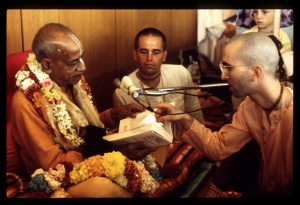CC Madhya 20.345 (1975): Difference between revisions
(Vanibot #0027: CCMirror - Mirror CC's 1996 edition to form a basis for 1975) |
(Vanibot #0020: VersionCompareLinker - added a link to the Version Compare feature) |
||
| Line 2: | Line 2: | ||
<div style="float:left">'''[[Sri Caitanya-caritamrta (1975)|Śrī Caitanya-caritāmṛta (1975)]] - [[CC Madhya (1975)|Madhya-līlā]] - [[CC Madhya 20 (1975)|Chapter 20: Lord Śrī Caitanya Mahāprabhu Instructs Sanātana Gosvāmī in the Science of the Absolute Truth]]'''</div> | <div style="float:left">'''[[Sri Caitanya-caritamrta (1975)|Śrī Caitanya-caritāmṛta (1975)]] - [[CC Madhya (1975)|Madhya-līlā]] - [[CC Madhya 20 (1975)|Chapter 20: Lord Śrī Caitanya Mahāprabhu Instructs Sanātana Gosvāmī in the Science of the Absolute Truth]]'''</div> | ||
<div style="float:right">[[File:Go-previous.png|link=CC Madhya 20.344 (1975)|Madhya-līlā 20.344]] '''[[CC Madhya 20.344 (1975)|Madhya-līlā 20.344]] - [[CC Madhya 20.346 (1975)|Madhya-līlā 20.346]]''' [[File:Go-next.png|link=CC Madhya 20.346 (1975)|Madhya-līlā 20.346]]</div> | <div style="float:right">[[File:Go-previous.png|link=CC Madhya 20.344 (1975)|Madhya-līlā 20.344]] '''[[CC Madhya 20.344 (1975)|Madhya-līlā 20.344]] - [[CC Madhya 20.346 (1975)|Madhya-līlā 20.346]]''' [[File:Go-next.png|link=CC Madhya 20.346 (1975)|Madhya-līlā 20.346]]</div> | ||
{{CompareVersions|CC|Madhya 20.345|CC 1975|CC 1996}} | |||
{{RandomImage}} | {{RandomImage}} | ||
==== TEXT 345 ==== | ==== TEXT 345 ==== | ||
| Line 20: | Line 19: | ||
<div class="synonyms"> | <div class="synonyms"> | ||
kṛte—in Satya-yuga; yat—which; dhyāyataḥ—from meditation; viṣṇum—on Lord Viṣṇu; tretāyām—in Tretā-yuga; yajataḥ—from worshiping; makhaiḥ—by performing sacrifices; dvāpare—in the | kṛte—in the Satya-yuga; yat—which; dhyāyataḥ—from meditation; viṣṇum—on Lord Viṣṇu; tretāyām—in the Tretā-yuga; yajataḥ—from worshiping; makhaiḥ—by performing sacrifices; dvāpare—in the age of Dvāpara; paricaryāyām—by worshiping the lotus feet of Kṛṣṇa; kalau—in the Age of Kali; tat—that same result (can be achieved); hari-kīrtanāt—simply by chanting the Hare Kṛṣṇa mahā-mantra. | ||
</div> | </div> | ||
| Line 27: | Line 26: | ||
<div class="translation"> | <div class="translation"> | ||
" 'Whatever result was obtained in Satya-yuga by meditating on Viṣṇu, in Tretā-yuga by performing sacrifices and in Dvāpara-yuga by serving the Lord's lotus feet can also be obtained in Kali-yuga simply by chanting the Hare Kṛṣṇa mahā-mantra.' | |||
</div> | </div> | ||
| Line 34: | Line 33: | ||
<div class="purport"> | <div class="purport"> | ||
This verse is quoted from Śrīmad-Bhāgavatam ( | This verse is quoted from Śrīmad-Bhāgavatam (12.3.52). At the present moment in Kali-yuga there are many false meditators who concoct some imaginary form and try to meditate upon it. It has become fashionable to meditate, but people know nothing about the object of meditation. That is explained here. Yad dhyāyato viṣṇum. One has to meditate upon Lord Viṣṇu or Lord Kṛṣṇa. Without referring to the śāstras, so-called meditators aim at impersonal objects. Lord Kṛṣṇa has condemned them in Bhagavad-gītā ([[BG 12.5 (1972)|12.5]]): | ||
:kleśo | :kleśo 'dhikataras teṣām | ||
:avyaktā hi gatir duḥkhaṁ dehavadbhir avāpyate | avyaktāsakta-cetasām | ||
:avyaktā hi gatir duḥkhaṁ | |||
:dehavadbhir avāpyate | |||
"For those whose minds are attached to the unmanifested, impersonal feature of the Supreme, advancement is very troublesome. To make progress in that discipline is always difficult for those who are embodied." | |||
The same | Not knowing how to meditate, foolish people simply suffer, and there is no benefit derived from their spiritual activities. The same reference can be found in the following verse from the Viṣṇu Purāṇa (6.2.17), Padma Purāṇa (Uttara-khaṇḍa 72.25) and Bṛhan-nāradīya Purāṇa (38.97). | ||
</div> | </div> | ||
Latest revision as of 13:20, 27 January 2020

A.C. Bhaktivedanta Swami Prabhupada
TEXT 345
- kṛte yad dhyāyato viṣṇuṁ
- tretāyāṁ yajato makhaiḥ
- dvāpare paricaryāyāṁ
- kalau tad dhari-kīrtanāt
SYNONYMS
kṛte—in the Satya-yuga; yat—which; dhyāyataḥ—from meditation; viṣṇum—on Lord Viṣṇu; tretāyām—in the Tretā-yuga; yajataḥ—from worshiping; makhaiḥ—by performing sacrifices; dvāpare—in the age of Dvāpara; paricaryāyām—by worshiping the lotus feet of Kṛṣṇa; kalau—in the Age of Kali; tat—that same result (can be achieved); hari-kīrtanāt—simply by chanting the Hare Kṛṣṇa mahā-mantra.
TRANSLATION
" 'Whatever result was obtained in Satya-yuga by meditating on Viṣṇu, in Tretā-yuga by performing sacrifices and in Dvāpara-yuga by serving the Lord's lotus feet can also be obtained in Kali-yuga simply by chanting the Hare Kṛṣṇa mahā-mantra.'
PURPORT
This verse is quoted from Śrīmad-Bhāgavatam (12.3.52). At the present moment in Kali-yuga there are many false meditators who concoct some imaginary form and try to meditate upon it. It has become fashionable to meditate, but people know nothing about the object of meditation. That is explained here. Yad dhyāyato viṣṇum. One has to meditate upon Lord Viṣṇu or Lord Kṛṣṇa. Without referring to the śāstras, so-called meditators aim at impersonal objects. Lord Kṛṣṇa has condemned them in Bhagavad-gītā (12.5):
- kleśo 'dhikataras teṣām
avyaktāsakta-cetasām
- avyaktā hi gatir duḥkhaṁ
- dehavadbhir avāpyate
"For those whose minds are attached to the unmanifested, impersonal feature of the Supreme, advancement is very troublesome. To make progress in that discipline is always difficult for those who are embodied."
Not knowing how to meditate, foolish people simply suffer, and there is no benefit derived from their spiritual activities. The same reference can be found in the following verse from the Viṣṇu Purāṇa (6.2.17), Padma Purāṇa (Uttara-khaṇḍa 72.25) and Bṛhan-nāradīya Purāṇa (38.97).